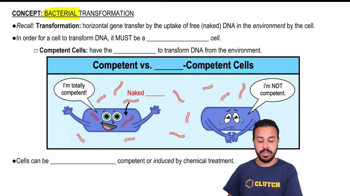Table of contents
- 1. Introduction to Biology2h 42m
- 2. Chemistry3h 40m
- 3. Water1h 26m
- 4. Biomolecules2h 23m
- 5. Cell Components2h 26m
- 6. The Membrane2h 31m
- 7. Energy and Metabolism2h 0m
- 8. Respiration2h 40m
- 9. Photosynthesis2h 49m
- 10. Cell Signaling59m
- 11. Cell Division2h 47m
- 12. Meiosis2h 0m
- 13. Mendelian Genetics4h 44m
- Introduction to Mendel's Experiments7m
- Genotype vs. Phenotype17m
- Punnett Squares13m
- Mendel's Experiments26m
- Mendel's Laws18m
- Monohybrid Crosses19m
- Test Crosses14m
- Dihybrid Crosses20m
- Punnett Square Probability26m
- Incomplete Dominance vs. Codominance20m
- Epistasis7m
- Non-Mendelian Genetics12m
- Pedigrees6m
- Autosomal Inheritance21m
- Sex-Linked Inheritance43m
- X-Inactivation9m
- 14. DNA Synthesis2h 27m
- 15. Gene Expression3h 20m
- 16. Regulation of Expression3h 31m
- Introduction to Regulation of Gene Expression13m
- Prokaryotic Gene Regulation via Operons27m
- The Lac Operon21m
- Glucose's Impact on Lac Operon25m
- The Trp Operon20m
- Review of the Lac Operon & Trp Operon11m
- Introduction to Eukaryotic Gene Regulation9m
- Eukaryotic Chromatin Modifications16m
- Eukaryotic Transcriptional Control22m
- Eukaryotic Post-Transcriptional Regulation28m
- Eukaryotic Post-Translational Regulation13m
- 17. Viruses37m
- 18. Biotechnology2h 58m
- 19. Genomics17m
- 20. Development1h 5m
- 21. Evolution3h 1m
- 22. Evolution of Populations3h 52m
- 23. Speciation1h 37m
- 24. History of Life on Earth2h 6m
- 25. Phylogeny2h 31m
- 26. Prokaryotes4h 59m
- 27. Protists1h 12m
- 28. Plants1h 22m
- 29. Fungi36m
- 30. Overview of Animals34m
- 31. Invertebrates1h 2m
- 32. Vertebrates50m
- 33. Plant Anatomy1h 3m
- 34. Vascular Plant Transport1h 2m
- 35. Soil37m
- 36. Plant Reproduction47m
- 37. Plant Sensation and Response1h 9m
- 38. Animal Form and Function1h 19m
- 39. Digestive System1h 10m
- 40. Circulatory System1h 57m
- 41. Immune System1h 12m
- 42. Osmoregulation and Excretion50m
- 43. Endocrine System1h 4m
- 44. Animal Reproduction1h 2m
- 45. Nervous System1h 55m
- 46. Sensory Systems46m
- 47. Muscle Systems23m
- 48. Ecology3h 11m
- Introduction to Ecology20m
- Biogeography14m
- Earth's Climate Patterns50m
- Introduction to Terrestrial Biomes10m
- Terrestrial Biomes: Near Equator13m
- Terrestrial Biomes: Temperate Regions10m
- Terrestrial Biomes: Northern Regions15m
- Introduction to Aquatic Biomes27m
- Freshwater Aquatic Biomes14m
- Marine Aquatic Biomes13m
- 49. Animal Behavior28m
- 50. Population Ecology3h 41m
- Introduction to Population Ecology28m
- Population Sampling Methods23m
- Life History12m
- Population Demography17m
- Factors Limiting Population Growth14m
- Introduction to Population Growth Models22m
- Linear Population Growth6m
- Exponential Population Growth29m
- Logistic Population Growth32m
- r/K Selection10m
- The Human Population22m
- 51. Community Ecology2h 46m
- Introduction to Community Ecology2m
- Introduction to Community Interactions9m
- Community Interactions: Competition (-/-)38m
- Community Interactions: Exploitation (+/-)23m
- Community Interactions: Mutualism (+/+) & Commensalism (+/0)9m
- Community Structure35m
- Community Dynamics26m
- Geographic Impact on Communities21m
- 52. Ecosystems2h 36m
- 53. Conservation Biology24m
14. DNA Synthesis
The Griffith Experiment
Problem 1`
Textbook Question
In his work with pneumonia-causing bacteria and mice, Griffith found that
a. The protein coat from pathogenic cells was able to transform nonpathogenic cells.
b. Heat-killed pathogenic cells caused pneumonia.
c. Some substance from pathogenic cells was transferred to nonpathogenic cells, making them pathogenic.
d. The polysaccharide coat of bacteria caused pneumonia.
 Verified step by step guidance
Verified step by step guidance1
Understand the context of Griffith's experiment: Griffith was studying two strains of Streptococcus pneumoniae bacteria, one pathogenic (causing disease) and one nonpathogenic (harmless).
Recognize the key components of the experiment: Griffith used heat-killed pathogenic bacteria and live nonpathogenic bacteria to observe the effects on mice.
Identify the main observation: Griffith found that when he mixed heat-killed pathogenic bacteria with live nonpathogenic bacteria, the nonpathogenic bacteria became pathogenic and caused pneumonia in mice.
Analyze the implication of the experiment: This suggested that some 'transforming principle' from the dead pathogenic bacteria was transferred to the live nonpathogenic bacteria, transforming them into pathogenic bacteria.
Conclude the correct answer: Griffith's experiment demonstrated that some substance from pathogenic cells was transferred to nonpathogenic cells, making them pathogenic, which aligns with option c.
 Verified video answer for a similar problem:
Verified video answer for a similar problem:This video solution was recommended by our tutors as helpful for the problem above
Video duration:
55sPlay a video:
Was this helpful?
Key Concepts
Here are the essential concepts you must grasp in order to answer the question correctly.
Griffith's Experiment
Griffith's experiment demonstrated the phenomenon of transformation, where a substance from heat-killed pathogenic bacteria could genetically alter nonpathogenic bacteria, making them pathogenic. This experiment was pivotal in suggesting that DNA might be the molecule responsible for heredity, as the transformation indicated a transfer of genetic information.
Recommended video:
Guided course

The Griffith Experiment
Transformation
Transformation is a process where genetic material from one organism is taken up by another, leading to a change in its genotype and phenotype. In Griffith's experiment, nonpathogenic bacteria acquired the ability to cause disease after being exposed to material from dead pathogenic bacteria, indicating the transfer of genetic information.
Recommended video:
Guided course

Bacterial Transformation
Pathogenic vs. Nonpathogenic Bacteria
Pathogenic bacteria are capable of causing disease, while nonpathogenic bacteria do not. Griffith's experiment involved the interaction between these two types, showing that nonpathogenic bacteria could become pathogenic through the uptake of genetic material from dead pathogenic bacteria, highlighting the role of genetic material in determining bacterial virulence.
Recommended video:
Guided course

Pathogen Defenses

 8:56m
8:56mWatch next
Master The Griffith Experiment with a bite sized video explanation from Jason
Start learningRelated Videos
Related Practice








